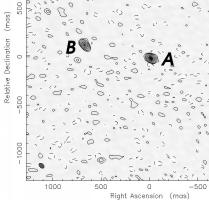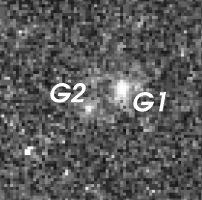Lens System Summary
B1127+385 is a double-image gravitational lens system. There are two lensing galaxies; the primary is between images A and B (but closer to A). In the infrared (H-band) the source appears as a near - Einstein ring. No redshifts are yet known for this system. This lens is not part of the statistically complete CLASS sample because it is too faint at 5GHz.
|
This Lens System
|
Lens name
|
B1127+385
|
|
Survey
|
CLASS
|
|
Images
|
2
|
|
B1950.0 coords
|
11h27m19.145s
|
38°28'35.770"
|
|
J2000.0 coords
|
11h30m00.099s
|
38°12'03.091"
|
|
Lens System Structure and Labelling
Image labelling for this lens (RA increases to the left, declination increases upwards)


|
Image/Lens Positions
|
Image/Lens
|
Relative Position
|
|
East (mas)
|
North (mas)
|
|
A
|
0.0±2
|
0.0±2
|
|
A1
|
0.0±0.1
|
0.0±0.1
|
|
A2
|
0.6±0.1
|
2.1±0.1
|
|
B
|
685±2
|
138±2
|
|
B1
|
686.6±0.1
|
140.1±0.1
|
|
B2
|
687.0±0.1
|
139.2±0.1
|
|
Image/Lens Separations
|
Separation (mas)
|
|
Component
|
A
|
A1
|
A2
|
B
|
B1
|
B2
|
|
A
|
|
0.0
|
2.2
|
698.8
|
700.7
|
701.0
|
|
A1
|
0.0
|
|
2.2
|
698.8
|
700.7
|
701.0
|
|
A2
|
2.2
|
2.2
|
|
697.8
|
699.7
|
700.0
|
|
B
|
698.8
|
698.8
|
697.8
|
|
2.6
|
2.3
|
|
B1
|
700.7
|
700.7
|
699.7
|
2.6
|
|
1.0
|
|
B2
|
701.0
|
701.0
|
700.0
|
2.3
|
1.0
|
|
|
Position angle (°)
|
|
Component
|
A
|
A1
|
A2
|
B
|
B1
|
B2
|
|
A
|
|
0.0
|
-164.1
|
-101.4
|
-101.5
|
-101.5
|
|
A1
|
0.0
|
|
-164.1
|
-101.4
|
-101.5
|
-101.5
|
|
A2
|
15.9
|
15.9
|
|
-101.2
|
-101.4
|
-101.3
|
|
B
|
78.6
|
78.6
|
78.8
|
|
-142.7
|
-121.0
|
|
B1
|
78.5
|
78.5
|
78.6
|
37.3
|
|
-24.0
|
|
B2
|
78.5
|
78.5
|
78.7
|
59.0
|
156.0
|
|
|
Maps and Images
Click on an image to see a larger JPEG version, or click on the accompanying text to
download a gzipped FITS or PostScript file of the map or image. The images and maps are
available in one gzipped file here.
To see a DSS image of the region around this lens, click here - note that you will have to start the search manually by clicking on the 'Search' button.
|
Radio Flux Densities
|
Component
|
Flux density (mJy)
|
|
1.7 GHz
|
5 GHz
|
8.4 GHz
|
8.4 GHz
|
|
A
|
16.0
|
15.3
|
14.7
|
|
|
A1
|
|
|
|
10.5
|
|
A2
|
|
|
|
3.2
|
|
B
|
14.0
|
11.5
|
11.8
|
|
|
B1
|
|
|
|
7.9
|
|
B2
|
|
|
|
2.9
|
|
Flux errors
|
10%
|
10%
|
10%
|
10%
|
|
Resolution (mas)
|
60
|
60
|
200
|
1.7
|
Map noise level
(mJy/beam)
|
|
|
|
|
|
Instrument
|
MERLIN
|
MERLIN
|
VLA
|
VLBA
|
|
Date observed
|
1996/02/13
|
1996/12
|
1995/08/14
|
1996/11/04
|
|
Reference
|
[1]
|
[1]
|
[1]
|
[1]
|
|
Sub-millimetre Flux Densities
|
Component
|
Flux density (mJy)
|
|
1300 μm
|
850 μm
|
450 μm
|
|
Total
|
<2.8
|
13.9±2.3
|
<65
|
Estimated
cal. error
|
|
5-10%
|
5-10%
|
|
Instrument
|
IRAM 30-m
|
SCUBA (JCMT)
|
SCUBA (JCMT)
|
|
Date observed
|
|
1999-2001
|
1999-2001
|
|
Reference
|
[2]
|
[2]
|
[2]
|
|
Optical Imaging
|
Component
|
Brightness (Magnitudes)
|
|
F555W (V)
|
F814W (I)
|
|
G1
|
22.5±0.1
|
24.4±0.2
|
|
G2
|
23.5±0.1
|
25.5±0.2
|
|
Instrument
|
WFPC2 (HST)
|
WFPC2 (HST)
|
|
Integration time
|
700s + 300s
|
2 exp. of
500s each
|
|
PSF size (arcsec)
|
|
|
|
Pixel scale (mas/pixel)
|
45.5
|
45.5
|
|
Date observed
|
1996/06/21
|
1996/06/21
|
|
Reference no.
|
[1]
|
[1]
|
|
Lens Models
Click on the model's reference number to go to the relevant paper's abstract on ADS.
[1] Koopmans et al. find that an acceptable mass model should include both G1 and G2. Such a model (using an SIE for G1 and SIS for G2) fits both radio and optical data with a reduced Χ2 of 1.1.
|
Notes
Redshifts for this system are currently unknown.
Variability monitoring has been conducted using WSRT.
|
References
Click here to see the CASTLES data available for this object, or here to search for references on NED. You can go to a paper's abstract on ADS by clicking its reference number.
-
[1] A new radio double lens from CLASS: B1127+385, L. V. E. Koopmans et al., Mon. Not. R. Astron. Soc. 303, Issue 4, pp. 727-735. (1999)
-
[2] A submillimeter survey of gravitationally lensed quasars, R. Barvainis and R. Ivison, Astrophys. J. 571, pp. 712-720 (2002)
|
Click here to go back to the database index page, or here to go back to the top of this page. |

